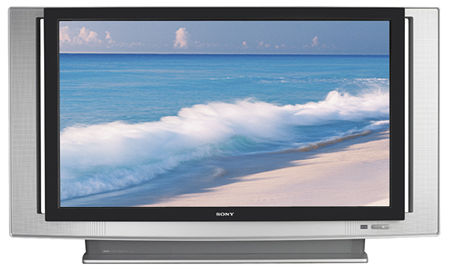Sony KDS-R60XBR1 SXRD 1080p RPTV

The picture looked fundamentally different and better than competing sets because, among other innovations, instead of using a light-impeding perforated metal grille aperture through which the electron beam fired, the patented Trinitron CRT used a series of vertical wires that passed far more light and produced a noticeably brighter, sharper picture.
Add distinctive industrial design to that crisp, attractive picture and Sony had the makings of a consumer electronics classic. Though the original Trinitron television was more expensive than the competition, it became both a bestseller and a desired status item.
Today the picture is not quite as bright for Sony, which is now regularly referred to in the press as ". . .the troubled electronic giant," thanks to missed opportunities like ceding the digital Walkman to Apple's iPod.
Yet, according to a November 1, 2005 Hollywood Reporter feature, new Sony CEO Howard Stringer is confident that he can turn the company around using an HD chain stretching from its vault of digitized movies to Blu-Ray, to PlayStation 3 and HD camcorders and then, he specified, to Sony SXRD-based displays.
The SXRD reference is significant because though Sony is heavily invested in LCD, it's clear that Stringer hopes SXRD technology will capture the public's imagination today as Trinitron did almost 40 years ago. Recapturing the public's imagination is the essential intangible vital to a dominant market position.
Sony's first SXRD product, the well-received, high-end ($30,000) Qualia 004 front projector, was proof of Sony's continued engineering prowess and brought much needed focus and prestige to the company. The $13,000 70" Qualia 006 rear projection set came next, and it set the standard, in most reviewers' eyes, for RPTV.
It was only a matter of time before smaller, more consumer-friendly priced models were introduced and that time is now, with Sony's $4000 KDS-R50XBR1 (50" diag.) and the $5000 KDS-R60XBR1 (60" diag.) reviewed here.
Never mind that many competitors are claiming the death of RPTV within a few years as plasma and LCD flat panel prices plummet. Sony is confident that the picture produced by its SXRD technology, combined with dramatic industrial design, will trump thin form factor. For that to be true, the picture had better be dramatically better—fundamentally different— than the competition's "flat screen" (and RPTV) models.
A Smaller SXRD Chip
The heart of these two new models is the third generation SXRD (Silicon Xtal—Crystal—Reflective Display) chip—an LCoS variant. With a display diagonal measurement of just 0.61 inches, Sony claims it is the world's smallest full 1080p (1920x1080- 2,073,00 pixels) microdisplay chip. Sony also claims that SXRD chip production is far more reliable than is typical of LCoS.
Unlike LCD, a transmissive technology in which light passes through the chip's liquid crystal layer, LCoS and SXRD are reflective, with light penetrating a liquid crystal layer and then reflecting off the mirrored backplane. Because the light passes through twice, the liquid crystal layer can be half as thick, cutting its response time 75% compared to LCD, according to Sony. Fast response time becomes critical when watching action events like sports.
The reflectivity also allows the transistors that modulate each liquid crystal cell to be hidden in the silicone backplane, instead of having to be placed in the same plane as the cells. This allows the dead space between pixels (or inter-pixel gap) to be so narrow as to almost be invisible. Sony claims the SXRD chip's 0.35-micrometer gap is the world's smallest, resulting in a "fill factor" (the percent of the panel actually devoted to producing the image) of over 90%, compared to LCD's typical 50% fill factor, which puts a "screen door" between the picture and the viewer.
Sony also claims that unlike most LCD chips which use Twisted Nematic (TN) crystals that turn white when in the "off" position, its Vertically Aligned Nematic (VAN) liquid crystals display black when no voltage is applied, resulting in a far higher contrast ratios compared to LCD. Sony claims 5000:1 for its third generation chip.
The Optical Engine
The three-chip optical engine is driven by a 120-watt Ultra High Pressure lamp that Sony claims has an unusually long life (up to 8000 hours). The light passes through three dichroic mirrors, resulting in filtered Red, Blue and Green light for each of the three SXRD panels. The light reflecting off the three panels goes through a prism/combiner, then passes through a motorized iris system Sony calls "Cinema Black Pro," then through a lens assembly and finally onto the screen.
The user configurable iris system performs two functions. The standard iris setting allows the set to compensate for ambient room lighting from dark to bright in six steps, with each picture mode (Vivid, Standard and Pro) separately configurable. The four advanced iris settings (one being "Off"), which are available in Pro Mode, dynamically respond to average screen brightness in the video signal, closing down for dark scenes to improve black levels and shadow details, and opening up so brightly lit scenes have better "pop." Finally, responding to criticism that its sets produce "orangey" reds, Sony claims its new optical filter technology improves the color gamut and extends the range of red tones, making them deeper and richer than before.
Finally there's Sony's WEGA Engine HD Processing, which, among other features, includes Sony's DRC (Digital Reality Creation) that de-interlaces 480i and 1080i signals and then "maps" them for the 1920x1080p display. User options allow you to customize detail and smoothness ("Reality" and "Clarity" respectively, in Sonyspeak) to obtain the best picture depending upon the quality of the input signal and personal preferences. CineMotion 3/2 pull-down compensation is also included.
- Log in or register to post comments






























































